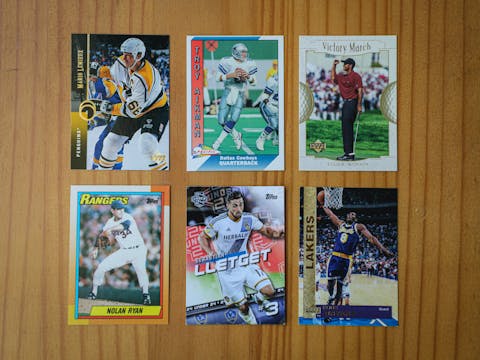Learn About Sports Cards
Sports have been a major part of Western culture since ancient times, and since the rise of radio and television during the 20th century, they have become more influential in our culture of entertainment than ever.
Babe Ruth
Today people collect sports cards as a way to have a tangible connection with the games and players that they love. Often time people start off their collections as children, growing their inventory from cards of their childhood favorite players to highly valuable and sought after collectible items. Today there is a steady and lucrative market for rare sports cards for people who wish to take their enthusiasm for sports a step further as well as appreciate these rare items as objects of history in their own right.
A history of sports cards
The history of sports cards is a relatively brief one, and the beginnings of these cards as we know them today can be traced back to the mid-nineteenth century in America. It was during this period that baseball was gaining a significant amount of popularity in the states, and as a result more people wanted to keep mementos to remind themselves of their favorite teams or players. As photography had only just recently become available as a technology, image printing techniques were rudimentary; one could paste a photograph of a player onto a piece of cardboard backing for displayal in a cabinet, thus earning the name ‘cabinet cards’, with carte de vistes being their smaller counterparts. Cabinet cards and carte de vistes could feature any genre of photography, most often family portraits, but some people did use them to collect images of their favorite teams and players whether at the amateur local youth leagues or beyond.

Civil War era sports cards
During the 1860’s a sporting goods company by the name of Peck and Snyder emerged, printing baseball cards to be used as advertisements for their products, the famous sports figures being featured on the front with the advertisement on the back. Known as trade cards, they were produced in large quantities and handed out for free to crowds on street corners. In the following decades, trade cards were often used as an effective marketing strategy and could feature not only sports subjects but anything from animals, presidents, and comics as well. These items remain sought after by collectors even today.
Sports cards as marketing
In the 1880’s it became popular for tobacco companies to print baseball cards and insert them into their packaging as both a stiffener and a means to incentivize buyers. Aside from these, some companies also included coupons with which you could save up and then send to them for a larger sports card. However by the 1890’s, most of these companies merged to form the American Tobacco Company, and decreased competition meant less need for such marketing strategies; few sports cards were produced during this time.
The 20th century & the golden era
But in the following decade, the American government sued to end the American Tobacco Company’s monopoly, and sports cards became a popular sales booster once more, coming back stronger than ever. In fact, many collectors regard the period of time between 1909-1915 to be the golden age of sports cards. Tobacco and candy companies created eye catching and even beautiful examples that are worth remarkable amounts of money on today’s collectible market.
Later on into the century, gum and candy companies became the main producers of sports cards, the audience for these products shifting heavily towards youth. Cards produced by Goudey Gum during the 1930’s are among some of the most popular today for their vividness in color and graphic nature of design, featuring household names like Babe Ruth.
"Sport card collecting grew within a matter of a few decades from a niche genre of photography to a marketing strategy to a nationwide cultural phenomenon that would embed itself deep into the identity of American youth and beyond."
Sports cards as we know them today
By the 1950’s, it was no longer the cards being included with the candy, but rather the other way around. Topps released cards that were big, bright, colorful, and featured player biographies on the back. Owner Sy Berger got professional players to sign promotional contracts with the company which quickly became a huge success and top of the industry, buying out their closest competitor, Bowman, only four years later. Sports card collecting among young boys became a culture of its own, lasting stil until the demographic children of the 1950’s grew into adults in the following decades.
Sport card collecting grew within a matter of a few decades from a niche genre of photography to a marketing strategy to a nationwide cultural phenomenon that would embed itself deep into the identity of American youth and beyond. With innocent roots in childhood enjoyment and pastimes, it is easy to see why so many people today remain endeared by the nostalgia of sports card collecting. As sports only grow increasingly influential in our culture as a now multi-billion dollar industry, it seems likely that our interest and sports and our athletic idols will only rise with it, and thus the sports card market will surely see another century in which to thrive.

